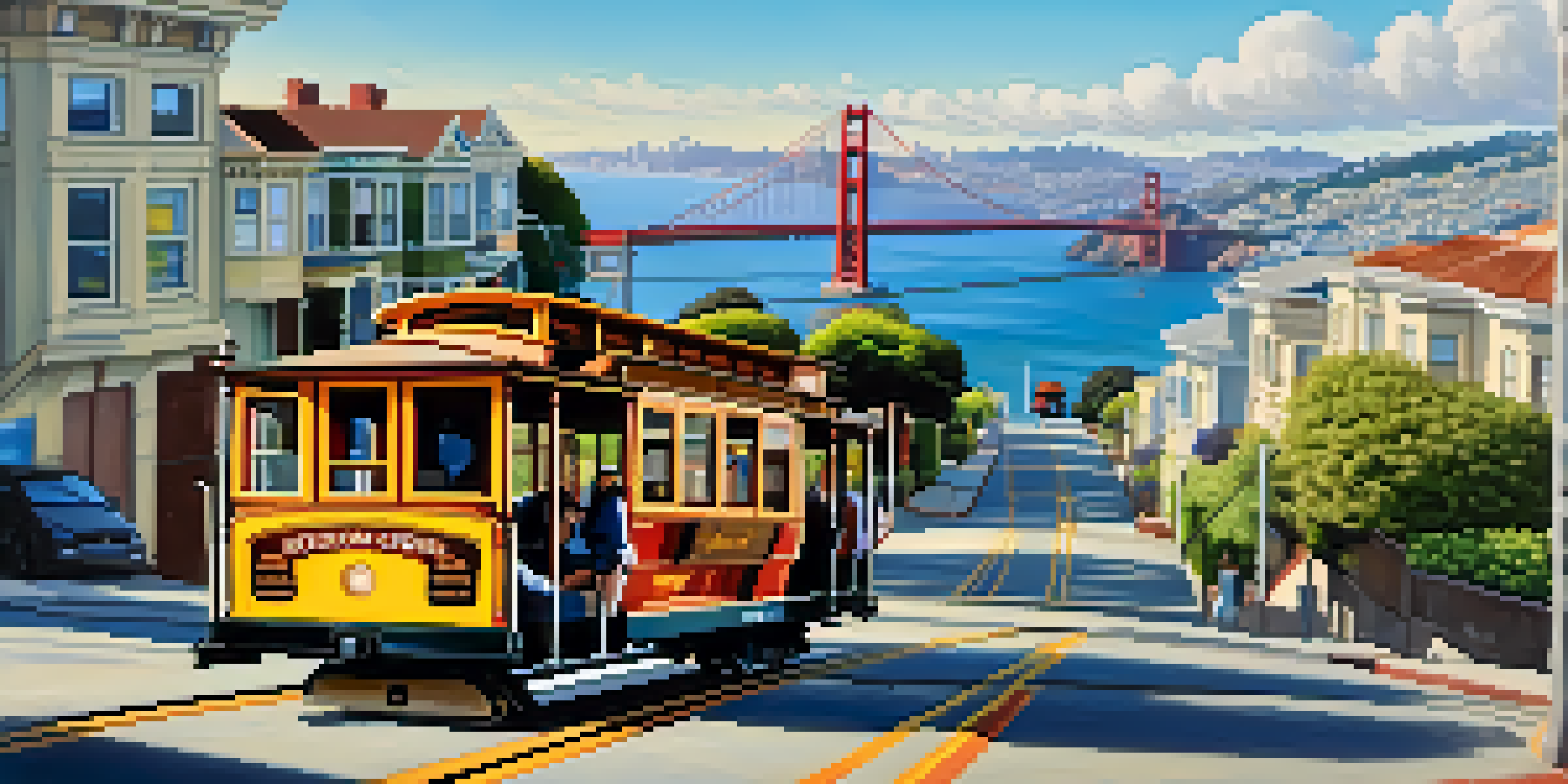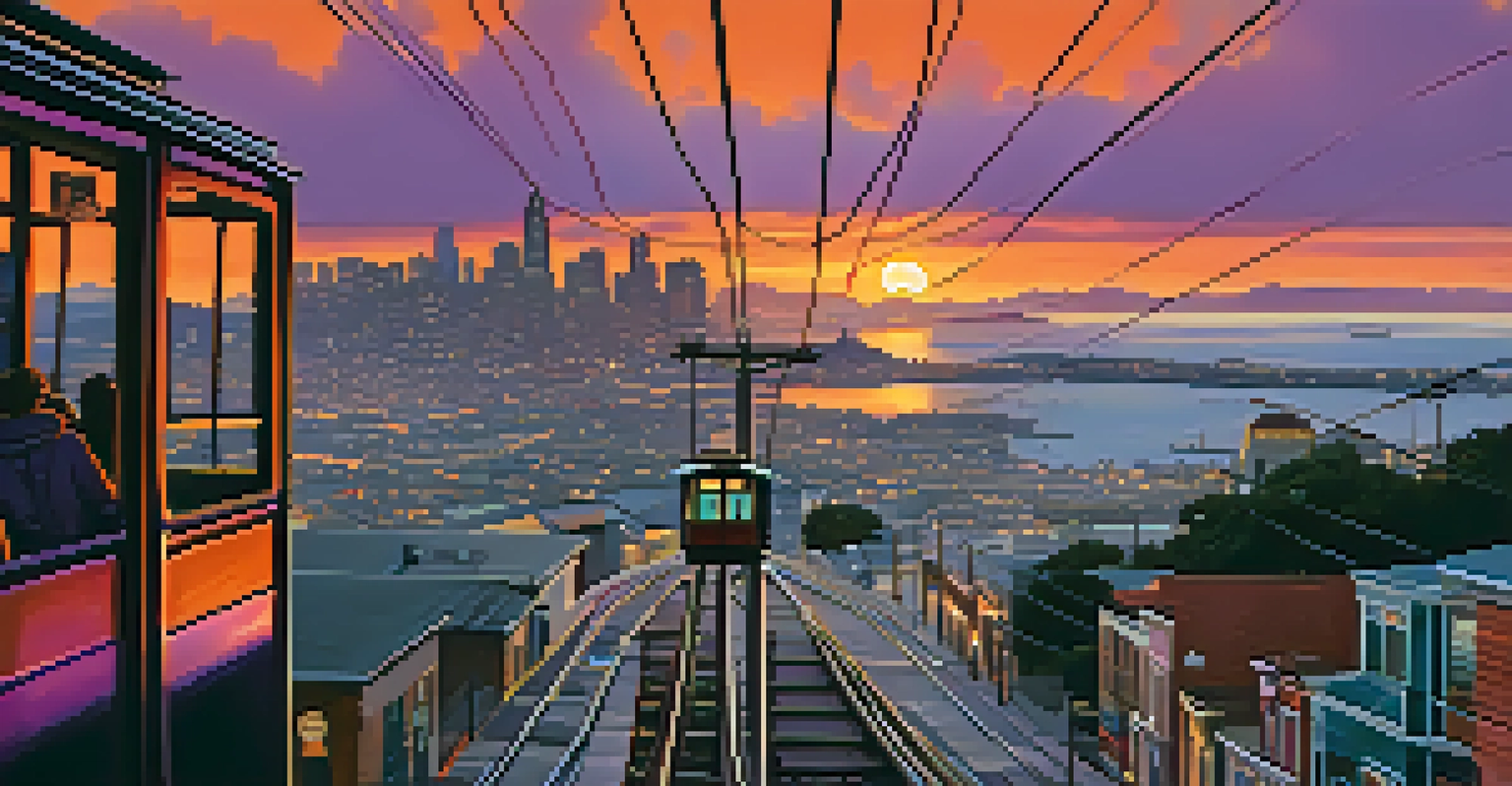Cable Cars: The Iconic Symbol of San Francisco's Transport

The Historical Roots of San Francisco's Cable Cars
Cable cars first rolled through the hilly streets of San Francisco in the late 19th century, making their debut in 1873. Their invention was a solution to the city's steep inclines, providing a reliable mode of transport. Andrew Hallidie, an engineer, is credited with creating this innovative system, inspired by the challenges faced by horse-drawn carriages on the slopes. The cable car system quickly became a vital part of the city's infrastructure, linking neighborhoods and allowing residents to navigate the terrain with ease.
The cable car is a living symbol of San Francisco's history and innovation, showcasing the city's ability to adapt and thrive amidst challenges.
As the city grew, so did the cable car network, expanding to reach various districts and making it easier for people to commute. At its peak, the system boasted over 600 cars operating on 23 lines. However, with the advent of streetcars and buses, cable cars began to decline in the mid-20th century. Despite this, their historical significance and charm led to a grassroots movement to preserve them, culminating in their designation as a National Historic Landmark in 1964.
Today, the cable cars are not just a means of transportation; they are a living testament to San Francisco's rich history. Tourists and locals alike flock to ride these iconic vehicles, enjoying not only the journey but also the views of the city's stunning architecture and scenery. The blend of history and functionality makes the cable cars an enduring symbol of San Francisco's identity.
How Cable Cars Work: The Mechanics Behind the Magic
At first glance, cable cars might seem like a simple mode of transport, but their operation is quite fascinating. Each cable car is connected to an underground cable that continuously moves at a steady pace, allowing the cars to ascend and descend the steep hills. Large sheaves, or pulleys, grip the cable, enabling the cars to be pulled along the tracks. This unique system is what gives cable cars their characteristic ability to tackle San Francisco's challenging terrain.

The cable itself runs underneath the street, and the cars are designed to engage with it using a mechanism known as the grip. When the grip engages the cable, the car moves forward; when it releases, the car slows down or stops. This design allows for precise control, making it possible for the cars to navigate sharp curves and steep inclines safely. The technology has remained relatively unchanged since its inception, which adds to the charm and nostalgia of riding a cable car.
Historical Significance of Cable Cars
Cable cars are a vital part of San Francisco's history, representing innovation and resilience since their introduction in 1873.
While modern transportation systems have evolved, the cable car's classic design continues to captivate riders. The experience isn’t merely about getting from point A to point B; it’s about the thrill of riding something that feels almost timeless. As you sit back and enjoy the ride, you’re not just commuting; you’re partaking in a piece of living history that has stood the test of time.
The Cultural Significance of Cable Cars in San Francisco
Cable cars are more than just a transportation option; they are an integral part of San Francisco's cultural fabric. They embody the spirit of the city, representing resilience and innovation. As tourists snap photos and locals hop on for their daily commutes, the cable cars serve as a connector between different generations and communities, fostering a sense of shared identity among San Franciscans.
To ride a cable car is to take a journey through time, experiencing the charm and nostalgia of a city that has always embraced change.
The cable car system has also inspired art, music, and literature, permeating various aspects of cultural life in the city. From the famous song 'I Left My Heart in San Francisco' to countless paintings capturing their essence, cable cars have found their way into the hearts of many. This cultural representation reinforces their status as an icon, transcending their practical function.
Moreover, the cable car system has become a symbol of San Francisco's charm, attracting millions of visitors each year. Whether it's a child's first ride or a couple's romantic outing, these experiences create lasting memories. The enduring appeal of cable cars ensures that they remain a beloved feature of the city's landscape, echoing the stories of those who have ridden them over the years.
The Scenic Routes: Enjoying San Francisco from the Cable Car
One of the best ways to experience San Francisco's beauty is from the vantage point of a cable car. As you ascend and descend the steep hills, you'll be treated to breathtaking views of the bay, the Golden Gate Bridge, and the city's iconic skyline. Each route offers its own unique perspective, showcasing the diverse neighborhoods and stunning architecture that make San Francisco special.
The Powell-Hyde line is particularly popular among tourists, offering panoramic views of the bay and the famous Lombard Street. Passengers can enjoy the thrill of the ride while soaking in the sights, making stops at various attractions along the way. Whether you're headed to Fisherman’s Wharf or Union Square, the journey itself becomes part of the adventure.
Unique Experience of Riding
Riding a cable car offers a memorable adventure, combining nostalgia with breathtaking views and a sense of community among passengers.
Taking a ride on a cable car is like being on a moving observation deck. With the breeze in your hair and the sounds of the city around you, you can’t help but feel a sense of connection to San Francisco’s vibrant atmosphere. It's a reminder that sometimes the journey is just as important as the destination, especially in a city as picturesque as this.
Preserving the Legacy: Maintenance and Challenges of Cable Cars
Maintaining the cable car system is a labor of love and an ongoing challenge for the city of San Francisco. Each car requires regular upkeep to ensure safety and functionality, which includes everything from mechanical checks to aesthetic restorations. The maintenance process is meticulous because the cable cars are not only a means of transport but also a piece of history that needs to be preserved for future generations.
In recent years, the system has faced various challenges, including funding issues and the impact of tourism. While the influx of visitors helps support the cable car operations, it also puts a strain on the infrastructure, necessitating upgrades and repairs. Balancing the needs of both locals and tourists is crucial to keeping the cable car system running smoothly.
Community involvement plays a key role in preserving the cable car legacy. Local organizations and enthusiasts often rally to support initiatives aimed at maintaining and enhancing the system. This collective effort ensures that cable cars remain not just a ride through the city, but a cherished part of San Francisco's identity for years to come.
The Unique Experience: Riding a Cable Car
Riding a cable car is an experience unlike any other, blending nostalgia with excitement. As you hop on, the clang of the bell and the rhythmic clatter of the wheels create an atmosphere of adventure. There’s something special about standing on the outside as the car climbs steep hills, feeling the adrenaline rush as you soar above the streets below.
Each ride offers a unique perspective, as you navigate through bustling neighborhoods and past historic landmarks. Passengers often chat with each other, sharing stories and recommendations, creating a sense of community among strangers. This interaction is part of what makes riding a cable car such a memorable experience.
Future Innovations and Sustainability
The cable car system faces opportunities for modernization and sustainability, aiming to enhance efficiency while preserving its historical charm.
In a world where technology often isolates us, cable cars provide a moment of connection—both to the city and to each other. Whether you’re a first-time visitor or a lifelong resident, the joy of riding a cable car is a reminder of the simple pleasures that come from exploring a city rich in history and culture.
Future of Cable Cars: Innovations and Sustainability
As we look to the future, the cable car system in San Francisco faces both opportunities and challenges. Innovations in technology and sustainability are becoming increasingly important as cities strive to reduce their carbon footprints. While cable cars are already a low-emission transport option, there’s potential for further enhancements to make them even more environmentally friendly.
One area of focus is the modernization of the cable car infrastructure, which could involve upgrading the grip mechanisms and cable systems. These improvements could enhance efficiency and reduce maintenance costs while preserving the historical charm of the cars. Engaging with the community for ideas and support is crucial in navigating this transition.

Additionally, promoting greater awareness about the historical and cultural significance of cable cars can help garner support for their preservation. By educating residents and visitors alike, the city can ensure that cable cars continue to thrive as a sustainable transport option while remaining a beloved symbol of San Francisco’s unique character.